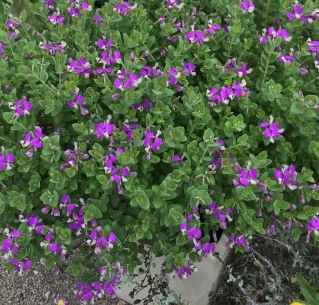Polygala Petite Butterfly is a compact evergreen shrub that is a true perennial and adored by gardeners all over the world. It bears pea-like flowers that are vivid purple-magenta with a soft-pink central crest. This lovely bush blooms nearly all year in mild winter climates. It is a great choice for a Wildlife Garden since it attracts bees, butterflies, and birds.
Sweat Pea Shrub is the popular name for polygala Petite Butterfly, which has pea-like purple flowers with two petals in the shape of wings and lacy centers. Compact grey-green foliage on pinkish stems accompanies its flowers, which bloom in cycles all the year. This shrub has a rounded growth habit and can reach a landscape size of 2-3 feet in almost two years of its lifespan. Polygala Petite Butterfly is a South African native that is frost sensitive and can only survive winters in USDA plant hardiness zones 9 and 10.
Polygala Petite Butterfly thrives in areas with both shade and full light in the summer and winter. In warm regions, sweet pea shrubs make excellent additions to mixed perennial borders, and they also look lovely in patio containers. Flowers in purple or mauve grow on these tidy, evergreen plants, making them ideal for bouquets and decorations.
Polygala Petite Butterfly Care
Sweet pea shrubs are simple to cultivate and maintain if given adequate sun and warm weather. The biggest issue is providing the proper amount of water at the right time, as well as pruning the plant regularly to keep it dense and full of flowers.
Sweet pea shrubs are most often planted from potted nursery plants in the spring. The planting area for the shrub is prepared at the same height as it was at the nursery’s container and a lot of organic material is required for plantation. Water the plant regularly while it grows, and feed it in the spring season.
Sweet pea bushes may thrive without a lot of extra water, but they look best when they are watered regularly. It should be kept in mind that plants cultivated in containers require more water than plants grown in the ground. Since Polygala Petite shrubs bloom all year, they benefit from a general-purpose fertilizer in the spring and fall.
The sweet pea bush thrives in full sun or mild scattered shade. This will ensure that it blooms profusely. Sweet pea shrubs can become extremely leggy with few flowers if they get too much shade.
Sweet pea shrubs can grow in a range of soils, but they prefer well-drained, fertile soil with enough organic matter. It dislikes soil that is too damp and thick. Although a slightly acidic pH is preferred, sweet pea shrubs can still thrive in neutral soil.
A balanced slow-release fertilizer is used in the spring for great blooming. A second feeding in the fall is typically beneficial in locations with very long flowering periods. Container plants may require light feeding monthly.
Polygala Petite Butterfly Size
Polygala fruticosa ‘Petite Butterflies’ has a compact, mounding growth habit, reaching 3 feet tall and wide when fully grown. It will benefit from some late-winter pruning to keep its compact shape. It is an ideal foundation plant for beachfront gardens because it is wind and salt spray tolerant. The average landscape size of this perennial shrub is 2-3′ x 2-3′.
Polygala Petite Butterfly Problems
The only pests that affect Polygala Petite Butterfly are whiteflies and aphids, which can be readily handled with horticultural oils or chemical insecticides.
The following are the common problems with this evergreen shrub:
- Sweet pea shrubs can become leggy as they grow older, with thick, woody stalks that produce few flowers. Although hard trimming can frequently help the plant recover, a very old sweet pea shrub may need to be destroyed and replaced with a younger plant in some cases.
- The other common problem with this plant is that too much water causes the yellowing of the leaves. With this plant, finding the right watering intervals can be difficult because it demands consistent moisture yet rebels if it receives too much. If the garden has had rain in recent weeks, do not irrigate this plant. It is important to make sure that the top two inches of soil are dry to the touch before watering again.
Polygala Petite Butterfly Pruning
This shrub tends to get leggy, cutting it in the early spring will keep it compact and clean. Pruning to remove poorly blooming lower stems on an annual basis will foster more profuse blooming. Pruning should be done after the major flowering periods have ended to prevent compromising blossoms.



